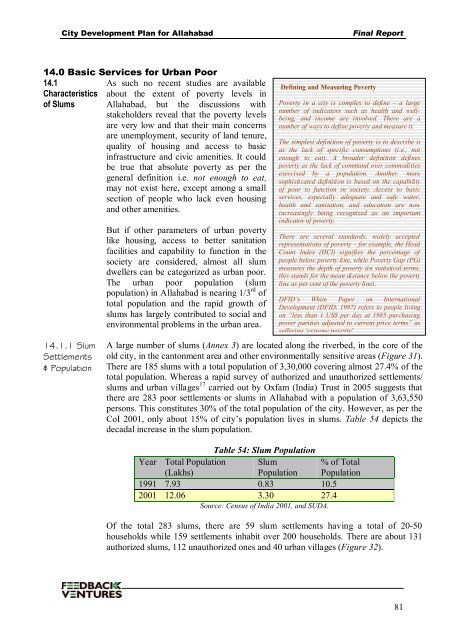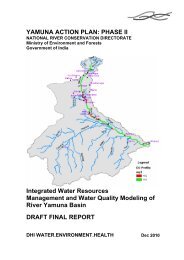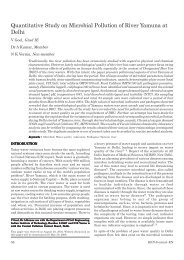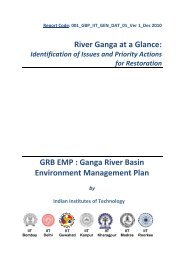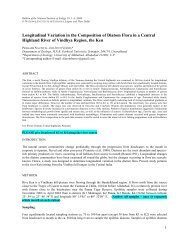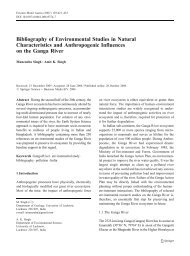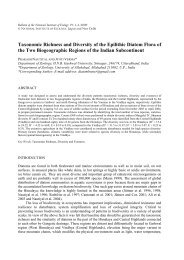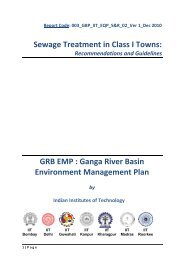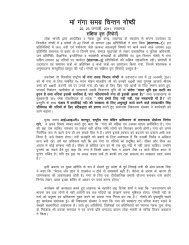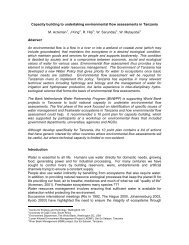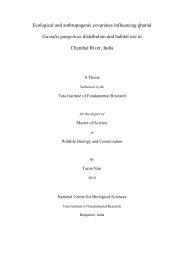Contents - GANGAPEDIA
Contents - GANGAPEDIA
Contents - GANGAPEDIA
You also want an ePaper? Increase the reach of your titles
YUMPU automatically turns print PDFs into web optimized ePapers that Google loves.
City Development Plan for Allahabad Final Report<br />
14.0 Basic Services for Urban Poor<br />
14.1<br />
Characteristics<br />
of Slums<br />
14.1.1 Slum<br />
Settlements<br />
& Population<br />
As such no recent studies are available<br />
about the extent of poverty levels in<br />
Allahabad, but the discussions with<br />
stakeholders reveal that the poverty levels<br />
are very low and that their main concerns<br />
are unemployment, security of land tenure,<br />
quality of housing and access to basic<br />
infrastructure and civic amenities. It could<br />
be true that absolute poverty as per the<br />
general definition i.e. not enough to eat,<br />
may not exist here, except among a small<br />
section of people who lack even housing<br />
and other amenities.<br />
But if other parameters of urban poverty<br />
like housing, access to better sanitation<br />
facilities and capability to function in the<br />
society are considered, almost all slum<br />
dwellers can be categorized as urban poor.<br />
The urban poor population (slum<br />
population) in Allahabad is nearing 1/3 rd of<br />
total population and the rapid growth of<br />
slums has largely contributed to social and<br />
environmental problems in the urban area.<br />
Defining and Measuring Poverty<br />
Poverty in a city is complex to define – a large<br />
number of indicators such as health and wellbeing,<br />
and income are involved. There are a<br />
number of ways to define poverty and measure it.<br />
The simplest definition of poverty is to describe it<br />
as the lack of specific consumptions (i.e., not<br />
enough to eat). A broader definition defines<br />
poverty as the lack of command over commodities<br />
exercised by a population. Another, more<br />
sophisticated definition is based on the capability<br />
of poor to function in society. Access to basic<br />
services, especially adequate and safe water,<br />
health and sanitation, and education are now<br />
increasingly being recognized as an important<br />
indicator of poverty.<br />
There are several standards, widely accepted<br />
representations of poverty – for example, the Head<br />
Count Index (HCI) signifies the percentage of<br />
people below poverty line, while Poverty Gap (PG)<br />
measures the depth of poverty (in statistical terms,<br />
this stands for the mean distance below the poverty<br />
line as per cent of the poverty line).<br />
DFID’s White Paper on International<br />
Development (DFID, 1997) refers to people living<br />
on “less than 1 US$ per day at 1985 purchasing<br />
power parities adjusted to current price terms” as<br />
suffering ‘extreme poverty’.<br />
A large number of slums (Annex 3) are located along the riverbed, in the core of the<br />
old city, in the cantonment area and other environmentally sensitive areas (Figure 31).<br />
There are 185 slums with a total population of 3,30,000 covering almost 27.4% of the<br />
total population. Whereas a rapid survey of authorized and unauthorized settlements/<br />
slums and urban villages 17 carried out by Oxfam (India) Trust in 2005 suggests that<br />
there are 283 poor settlements or slums in Allahabad with a population of 3,63,550<br />
persons. This constitutes 30% of the total population of the city. However, as per the<br />
CoI 2001, only about 15% of city’s population lives in slums. Table 54 depicts the<br />
decadal increase in the slum population.<br />
Table 54: Slum Population<br />
Year Total Population Slum % of Total<br />
(Lakhs)<br />
Population Population<br />
1991 7.93 0.83 10.5<br />
2001 12.06 3.30 27.4<br />
Source: Census of India 2001, and SUDA.<br />
Of the total 283 slums, there are 59 slum settlements having a total of 20-50<br />
households while 159 settlements inhabit over 200 households. There are about 131<br />
authorized slums, 112 unauthorized ones and 40 urban villages (Figure 32).<br />
81


